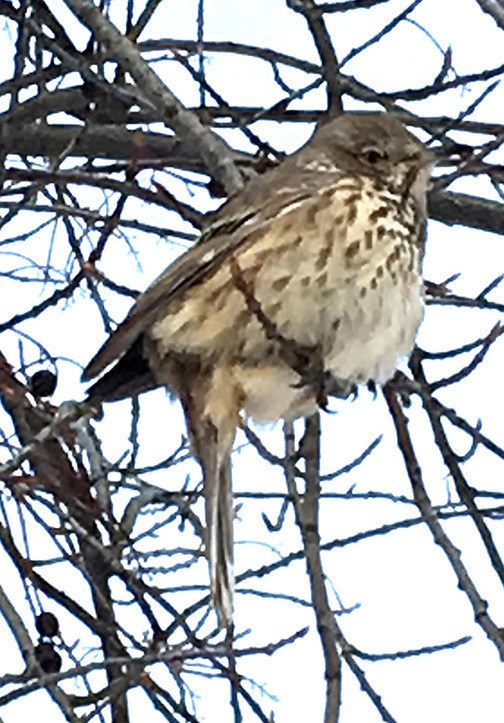Ian Adams
And you may ask yourself, Well, how did I get here? (Talking Heads, from “Once in a Lifetime”)
The bird clearly wasn’t happy. Cold, no doubt hungry. It was huddled on the sidewalk up against a building in downtown Cranbrook desperate for some warmth. As I walked past, it reluctantly flushed up into a nearby tree. Something seemed different about it. In the next tree a murmuration of starlings nattered away. This bird wanted no part of that group.
During my winter in Yukon, we gauged the temperature using “the fat bird index.” The colder it is, the more birds fluff out their feathers to keep warm. This bird was as fluffed as it could be. Couldn’t blame it, really. The day was December 9, near the beginning of our recent cold snap. After a prolonged autumn of that was neither hot nor cold, the temperature had headed south in a big way. Unfortunately, this bird hadn’t.
I stopped to look at the bird and got a good look from underneath. There was nothing particularly noteworthy. Mostly drab brown with streaked breast but few immediate clues. A birding friend Dean stopped by that afternoon to have a look and took some better pictures. That was the last anyone has seen of the bird.
Turns out the bird was a Sage Thrasher and it has no business being anywhere north of Arizona at this time of year. Sage Thrashers barely make it into southern B.C. during the summer, never mind December. Even then, they are usually only found in their eponymous sagebrush habitat of the south Okanagan. There is only one previous record of the species in the East Kootenay.
Turns out it’s not the only avian oddity of late. A spate of rare bird sightings has occurred that has many people scratching their heads.
During the Fernie Christmas Bird Count, a Virginia Rail was spotted wading through some open water. Like the Thrasher, these water birds should be in the southern U.S. by now on their winter grounds.
Then on December 19, a Mountain Bluebird – one of the true first signs of spring in the East Kootenay – was seen in the snow flurries at the airport. What is going on with these bird sightings and are they anything out of the ordinary? The B.C. Field Ornithologists track rare bird reports and so far this fall, the total number of reports has not been out of line with other years.
But the quick descent from mild fall into mid-winter during the first week of December may well have caught several birds off-guard. The accompanying graph of max/min temperatures from the airport shows the sudden drop of temperatures from a rather genteel November.

Daily maximum and minimum temperatures at Canadian Rockies International Airport, Oct. 2 to Dec. 19, 2016. Source: Environment Canada.
Fall bird migration is driven by a number of factors: fading daylight, weather conditions, food availability and learned behaviour. Interestingly, most small songbirds migrate at night. Some travel non-stop once they head out, others stop daily to refuel along the way. Short distance migrants — of which the thrasher, rail, bluebird and junco would all apply — tend to leave later. The lack of cold, particularly at night, through November may have lulled them into sticking around longer than they should have.
Not surprisingly, birds will wait for ideal weather conditions. North winds bring a chilly reminder of impending winter but more important for migration is a good tail-wind for moving south. Weather radar can detect large flocks of birds heading south and weather maps sometimes clearly show large flocks following cold fronts deep into the southern USA.
Climate change is bringing more unpredictable weather. Species that are able to adapt to new conditions will be the ones to persist. Bluebirds and juncos are often caught in spring or fall snowstorms or cold snaps. I’m not sure either the trasher or the rail are quite as ready for blasts of winter. The prognosis for both of those individuals isn’t good.
